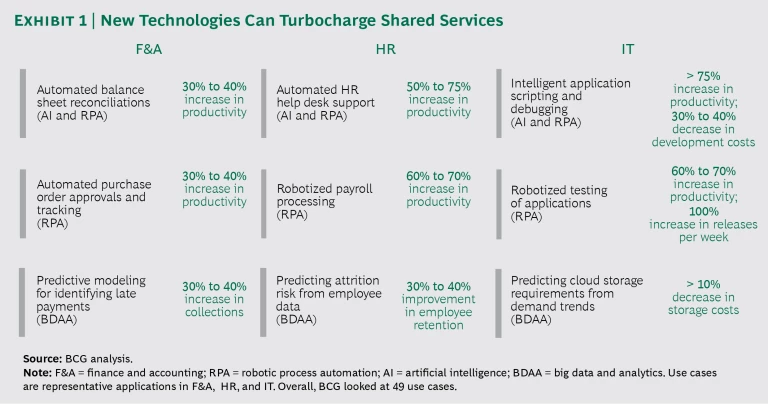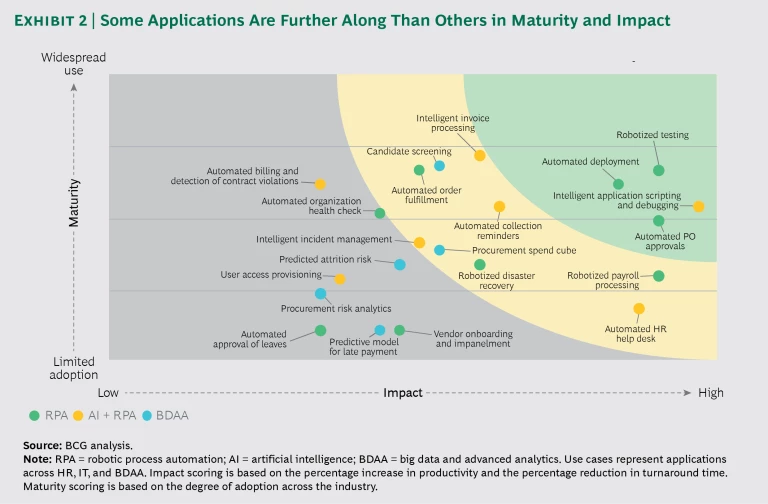Technologies such as artificial intelligence (AI) and robotic process automation (RPA) are joining the mainstream, and they’re coming to a shared-services center near you. In many cases, they bring big promises of disruption in the form of dramatically improved efficiency and effectiveness and great reductions in human effort. A compelling proposition—if it actually happens.
To be sure, many of the applications are innovative. Some companies, for instance, now use AI to transform the way they conduct early-round job interviews.
Candidates who might previously have been summoned to a potential employer’s office now use their smartphones to video themselves answering questions. The AI platform compares each applicant’s responses—down to tone of voice and facial expression—with those of successful employees, allowing the company to tie up fewer recruiters and devote less time to candidate screening while quite likely delivering better results.
Across such functions as HR, IT, and finance and accounting (F&A), solution providers are singing a similar refrain: let’s apply a new technology to a traditional process and do it faster, better, and cheaper. More disruptive yet, providers are applying these technologies to processes meant to deal with such genuine business problems as how to assess the credit worthiness of loan seekers. But is this next generation of shared services really living up to its billing? In a recent study, The Boston Consulting Group determined that in many cases, companies are not seeing the results that they’d expected. What’s holding up the payoff? Often, the finger can be pointed at a common set of challenges—obstacles that with the right planning and foresight could be overcome.
Disruption or Something More Modest?
In our study, we looked at 49 use cases: real-world applications of such technologies as AI and machine learning, RPA, natural-language processing, and big data and analytics (BDAA) in shared services that focus on HR, IT, and F&A.
It’s easy to understand the excitement these technologies generate. AI and sophisticated analytics, for example, are being incorporated into a host of applications such as intelligent incident management, attrition risk prediction, collections management, and training-curriculum design. And in some cases, these technologies are breaking new ground. One company in our study was able to teach an AI tool to identify the cause—and potential resolution—of IT incidents by “feeding” it data on past incidents and resolutions. Another company used RPA to automate the new-hire setup process: software bots—all operating around the clock—pull data from Excel files to create employee IDs, allocate workspace, update distribution lists, and create 90 different types of documents, including confidentiality agreements, employment contracts, and relocation forms.
The benefits of such next-generation processes are not trivial—or theoretical. In the incident management example, the AI tool reduced the manual effort required for troubleshooting problems in a complex IT architecture. In the new-hire setup example, RPA reduced turnaround time by more than 90%, simultaneously improving accuracy. Whereas 70% of documents were error free before the company deployed its new process, nearly 100% have been error free since the bots were unleashed.
Indeed, in some of the cases we examined, the distinctions between the before and after pictures were quite compelling. (See Exhibit 1.) At one large global company, the HR department’s limited capacity for answering queries from its more than 60,000 employees had led to widespread dissatisfaction. Upon close inspection, the company discovered that some 80% of employees’ queries were related to four themes. By automating its HR help desk—digitizing its HR handbook, creating an online knowledge base, and deploying chatbots and natural-language processing—the company was able to respond to most queries in real time, routing only nonaddressable queries to HR staff. Transaction costs decreased by 65%.
Overall, in nearly a quarter of the cases we examined, productivity improved by 40% or more. For a similar number, turnaround time was reduced by 70% or more.
But we also found that, in many cases, benefits either did not materialize to the degree companies expected or were achieved only with a significant—and surprising—amount of effort. Consider two examples from our study.
A large bank had attempted to apply RPA to its new-hire performance audits. As this was a simple, rules-based activity, the company expected to reduce processing time by more than 50%. But to work, the RPA tool needed to draw data from three different sources: email, a data warehouse, and an enterprise resource planning system. Complicating matters further, the data in the email was unstructured, and the data in the warehouse was of poor quality. For instance, an offer date might be later than a joining date. Significant manual intervention was needed before the data was suitable for RPA. And every few months, when assessment questions or metrics changed, the bank would have to take the RPA tool offline and reconfigure it. In the end, the productivity gain—not even 20%—was far less than the bank had anticipated.
A top logistics and shipping company decided to employ RPA and AI to streamline its process for providing and tracking user access to IT infrastructure (including files, servers, and applications). The idea was to create a self-service environment in which employees could complete an online form to request access and an automated system would vet requests, manage approvals, and monitor use. But the anticipated benefit—a 35% to 45% reduction in turnaround time—was offset by substantial implementation challenges. In order to train the AI tool, the company had to migrate a large archive of unstructured, paper-based requests to a data warehouse and to employ a high degree of change management for training 240,000 employees to use the new system.
Companies are largely on their own as they plan for and deploy next-generation shared services. Many applications are not yet widely used, and the efficacy of many remains unproven. (See Exhibit 2.) So there is little in the way of lessons learned and best practices to provide guidance. And standards—which have driven previous generations of shared services—have yet to emerge.
Given such uncertainty and unpredictability, how can companies ensure the best outcomes? Our study sheds light on where—and how—companies should focus.
Six Main Challenges
Finding that the same handful of implementation challenges appeared time and again, we identified six common problems that, sooner or later, dampen an application’s payoff.
Use of the Application in a Vacuum Rather Than as One Element of a Digital Strategy. Many companies embrace a new application without crafting—and meeting—a clear set of requirements for making it work. Consider, for example, the intelligent processing of nonstandardized invoices. In theory, such an application should automate accounts payable, helping companies realize significant productivity improvements and ROI—generally on the order of 30% and 60%, respectively. In practice, however, many companies fail to achieve such returns because they haven’t laid the proper groundwork. For example, they may still be using paper-based invoices—scanning them and editing them manually—or doing other things that make automation difficult. Without a wider digital strategy that ensures that invoices are in a form that works well with automation, companies are unlikely to realize the full benefits that AI and RPA solutions can bring.
Limited Understanding of How Next-Generation Solutions Do—or Do Not—Fit Within a Company’s Unique Environment. Traditional solutions have been “around the block” and then some, with standardized systems deployed—and proven—on a global scale. Most companies generally know what a particular solution can do for them, and provider selection tends to boil down to price, the ability to customize a few industry-specific processes, and the provider’s promises of ongoing improvement. But when it comes to solutions based on newer technologies, such as RPA, AI, and BDAA, there is much more variation and uncertainty. The relative immaturity of many applications, along with the lack of standards, can lead many companies to rely too heavily on a provider’s claims and assurances—a problem that frequently leads to unrealistic expectations.
Inconsistent or Changing Workflow, Formats, and Input. RPA systems do a great job of following rules for automating processes and extracting information from standardized documents. But each time processes or document formats change, the rules change and companies have to recode the RPA tool. These systems also run into trouble when input quality is poor or when formats are inconsistent. Meanwhile, country- or region-specific workflows, which account for local practices and regulatory issues, can ratchet up the costs and time required to implement RPA-based solutions.
Lack of Data for Machine Learning, Cognitive Processing, and BDAA. Most AI and BDAA tools need to process large volumes of data before they can do their job. For instance, in order to “learn” how to spot the potential for a system crash, an AI tool needs to sift through performance data from earlier crashes to identify patterns that signal trouble. The necessary data is rarely available in a readily consumable format, and companies often expend considerable time and effort in locating and restructuring it. This work can delay the implementation—and payoff—of a new application.
Systems Integration Challenges. In complex IT environments that run multiple types of servers and applications, it can be difficult to integrate new AI and RPA systems. Companies need to apply considerable testing, expertise, and resources to tie everything together.
Limited In-House Ability to Manage the Solutions. Many organizations lack the personnel required to evaluate, implement, and maintain solutions that use technologies such as RPA and AI. Many have difficulties adapting to the changes their new tools require. To get the biggest bang from next-generation shared services, companies often find that they need to reconfigure their workforce and ways of working. The inability to do this—or at least, to do it well—is an impediment to success.
Building a Foundation for Success
The good news is that companies can take steps to tackle and beat back the challenges. A savvy—and ultimately successful—approach to next-generation shared services embraces several imperatives.
Develop a clear and comprehensive business case for next-generation solutions. Before implementing a new solution, a company must identify all the requirements for making that solution work. It needs to understand the effort, resources, and costs necessary to meet those requirements and factor them into the business case for adopting the solution. This calculus is different for every business, which is precisely why every company has to work it out—and get it right.
Consider once more the invoice-processing example. Some companies’ invoices are already in a consistent digital form that allows for automating the process from the outset. But other companies may need to integrate multiple solutions—such as optical character recognition to read handwritten invoices and AI to detect different types of aberrations—before they can automate the process. These extra steps affect the cost—and the business case—for the intelligent processing application. Indeed, once they have adjusted the business case, some companies may no longer be able to justify the investment, particularly when the shared-services center is already in a low-cost location.
Craft a well-designed provider strategy that creates and engages partners in success. In today’s yet-to-mature application landscape—in which standards are elusive, many providers lack long track records, and different products are optimized for different environments—it’s difficult for companies to home in on the right solution. But the following guidelines can help:
- Cast the net wide and vet the most promising providers through proofs of concept or reference implementation checks.
- Early in the selection process, involve the CIO or CTO in testing the robustness of proposed solutions and their compatibility with the existing IT architecture.
- Bring in the procurement chief to ensure that deals include the right service-level agreements (SLAs) and payment strategies that incentivize providers to deliver the promised solutions. For example, companies can award providers an increasingly generous share of returns once targets specified in an SLA are exceeded.
Keep in mind, too, that collaboration with a provider does not—or at least, should not—end with solution implementation. RPA-based solutions may need reconfiguration as legacy environments, workflows, regulations, and contract terms change. AI solutions, meanwhile, require continuous tweaking that optimizes their ability to learn. Companies must ensure that their providers can—and will—provide support over the medium term. A carefully crafted contract that emphasizes and incentivizes ongoing collaboration is a must.
Consider how processes and data architecture should be reengineered. The most successful applications in our study share a key characteristic: they were implemented as part of an integrated transformation program. In these instances, companies didn’t simply plug in a new tool. They also reengineered processes and data architecture in ways that helped the new tool do its job. For example, some companies redesigned their data environment so that AI solutions could more easily access relevant datasets. The idea is to think holistically and understand how all the necessary pieces—the solution and related resources and processes—fit together best.
Retrain the workforce. Leading providers of IT services have recognized that those who implement, use, and manage technologies such as AI and RPA require new skills. To develop the requisite capabilities, providers have set up large-scale training programs. Shared-services organizations that plan to use next-generation solutions should consider following suit. They can start by identifying new job roles, assessing current employees, and pinpointing retraining needs. Developing new capabilities has an upside that goes beyond managing next-generation solutions. When companies have the skills in-house, they can challenge providers’ approaches to product design and pricing—and get better results and value.
Don’t rule out outsourcing—or the strategic role it can play. Automated and intelligent shared services don’t spell the end of outsourcing. Indeed, for back-office processes that lack sufficient scale, outsourcing makes a lot of sense. Outsourcing can also provide the manual support that may be needed while new solutions are being brought online. An AI-based solution, for example, may need many months of data training before it works with little or no manual intervention. An AI application implemented at one financial services company could, even after six months, automate only 30% of the jobs it was fed. Indeed, it took two years to reach 90%. It is important to note, however, that as the new shared services mature and automation increases, outsourcing models will likely change, and payment will be based less on head count and more on outcomes.
The digital era has sparked no shortage of high-profile disruption in how we work, learn, and live. But it is also having a less visible, behind-the-scenes impact. Emerging technologies such as RPA, AI, and BDAA are changing and automating the way companies perform traditional back-office processes and infusing them with intelligence. Businesses are starting to benefit—but not to the level that is possible. With the right strategy—engaging with the right providers, designing the right processes, identifying the right uses and business cases—companies can close that gap and realize the full potential of next-generation shared services.












